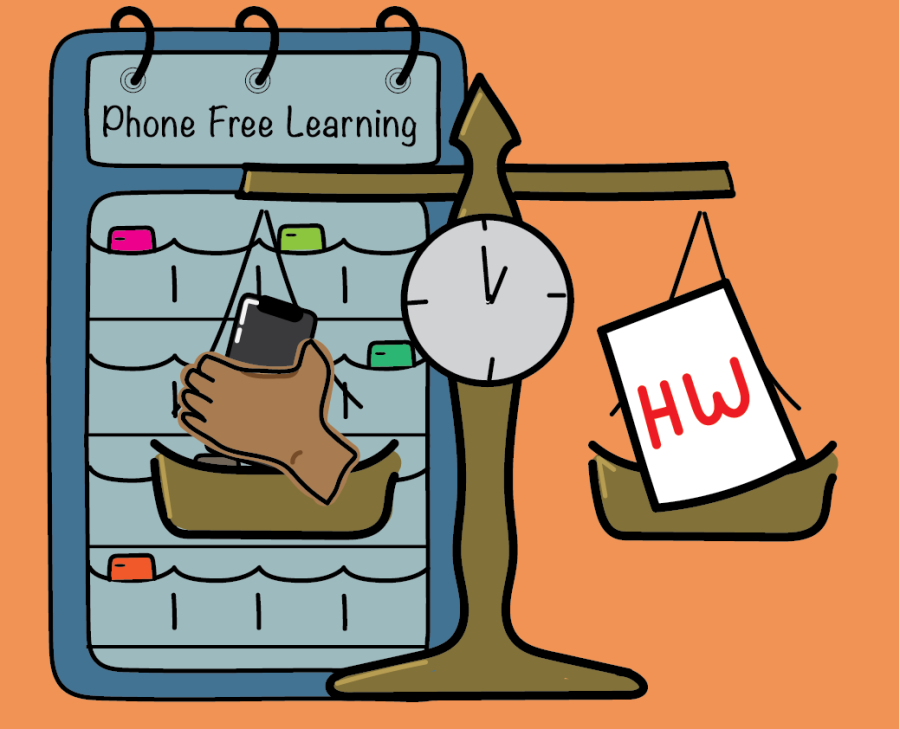“Phone Free Learning” can be helpful but it has its flaws
Here at Bowie, teachers have been cracking down on the phone guidelines to keep their classroom a phone-free environment.
Many Austin ISD schools face the battle between students and their smartphones. In fact, this district has now been enforcing a phone policy titled “Phone Free Learning.” Phone Free Learning is an initiative that schools have implemented so students are not being distracted by their phones. It is expected that students will put away their device and will not use it unless for strictly instructional purposes. By enforcing this rule, teachers and administrators believe that students will be more engaged in class, as well as not feeding into the temptation to check their devices during lessons.
Here at Bowie, teachers have been cracking down on the phone guidelines to keep their classroom a phone-free environment. Depending on the teacher’s rules, most students will have to put their phones up in a phone caddy or basket so that it is away from the students’ access. By putting students’ devices away, teachers can see less digital distractions in their classrooms.
From the perspective of a student, I have a fifty-fifty tolerance for the rule. I know that the majority of students feel more comfortable having their phone on them, however I’m also aware of the distraction that the device can cause. For safety reasons, having your phone on your person, but away is how the policy should be regulated. This can be that your phone is face down on a desk, in your backpack, or in your back pocket. This makes it so that your phone is not in your hands but it is still within reach.
Furthermore, smartphones and other electrical devices are a common usage in our society today. The use of smartphones doesn’t have to be all negative, students can use their device as tools in their learning; it doesn’t all have to be about social media and notifications. For many classes there are apps that students can access by their devices that act as an educational tool to help improve their learning.
In a language class, apps such as duolingo are used by students to provide extra help with pronouncing, writing, and using the language in sentences. For students who need more time to learn a subject YouTube is a great app that students use to comprehend previously taught lessons to better prepare them for assignments, quizzes, and tests.
In addition, music is also another tool kids can access by their device, and should be allowed during class time. For some students, listening to music while working on assignments allows them to concentrate on those assignments, and drown out any other distractions that are happening around them.
A study from Dan Brennan shows that while listening to music your body releases a chemical in the brain called dopamine. This chemical enhances motivation and production with simple daily tasks like cleaning the house, doing homework,or organizing your room. Dopamine stimulates brain activity, so when students listen to music and the chemical is released, kids are able to be more productive and are more likely to get their work done on time. Classical music specifically has been seen to increase productivity and lower stress levels for students in school.
Having balance between phones and learning is key. For classrooms where students struggle controlling their time spent on their phone, I think then is the perfect time to include a rule where phone usage is regulated. Where there’s a multitude of digital disruptions it makes it easier for students to multitask and slack on their work. Studies from JD Solomon show that 70% of students in the classroom spend time texting, web surfing, checking social media and playing games. When students are distracted like this there is no learning for the kids and no mental growth. Because of this, having a rule that works for the teacher and student can reduce the amount of time students spend online and increase the amount of time a student receives directive learning.
For instance, in my math class, my teacher has a system that works perfectly for the students and the teacher. Instead of walking into class and putting your device in a phone caddy, you sit at your desk and put your phone in a marked box on the corner of the desk. Throughout class, my teacher will give a three minute phone break to reply and check any notifications that you received during class. It is also up to the student to decide whether they want to use that break.
Overall, the designated phone breaks decrease the temptation for students to check their phone every couple minutes because there is a designated time the teacher has set for them to check the notifications. This system works well in our class because there is no forced restriction with phones, but still a separation between your device and class learning time.
Phone free learning can be both helpful and jeopardizing for high school students. Phones can act as tools that can improve a students education but can also be a big distraction. So, having an equal balance between cellphones in class and teacher taught learning is important for a student’s success.
Your donation will support the student journalists of James Bowie High School. Your contribution will help cover our annual website hosting costs. Any contributions made through this service are NOT tax deductible. If you would like to make a tax deductible donation OR to subscribe to our print edition, please contact us at [email protected].



